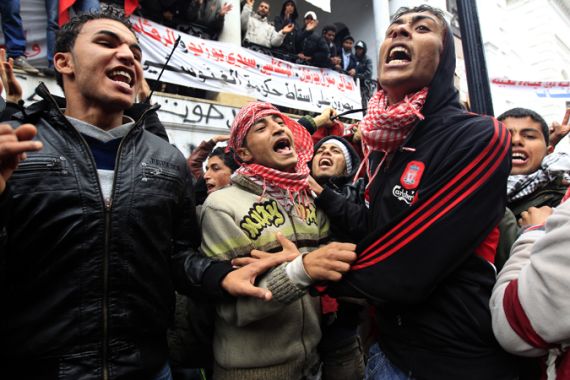Tunisia’s neglected interior builds itself up
Cut off from bulk of Tunisia’s economic development, residents of rural towns are creating their own opportunities.

Tunis, Tunisia – Almost four years after street vendor Mohamed Bouazizi set himself on fire to protest dire economic conditions in the city of Sidi Bouzid, people in the country’s interior are still struggling to make a living in post-revolution Tunisia.
“Tunisia had a revolution for more equality and freedoms, but we still need to empower the people, especially in the rural interior regions. They need jobs,” said Adel Thabti, from the Al Hycienne Development Association in the governorate of Kairouan in central Tunisia.
Tunisians from the country’s interior triggered the uprising that ousted President Zine el-Abidine Ben Ali in 2011. But since Ben Ali’s removal from power, political instability and security concerns have increased economic hardship among people in Tunisia’s rural south, centre, and northwest, who remain cut off from the bulk of economic activity.
Like many people from the interior, Thabti left home for the capital Tunis as a teenager to attend university and find a job. Now, he goes back home about once a month to support his family, and other people in his hometown.
The Al Hycienne Development Association is currently working to launch a small distillation company to extract oil out of the rosemary flower, which grows in the rural countryside. “We need distillation equipment ourselves to create employment in our town and improve our quality of life,” Thabti said.
RELATED: Small Tunisian firms struggle to turn profits
In addition to economic opportunities, education and health in Tunisia’s rural villages are also lagging behind the capital.
The African Development Bank Group’s interim strategy report for Tunisia (2014-15) found that education levels in Tunis were 30 times higher than in the Kasserine governorate in the centre of the country. The quality of health services, meanwhile, was 11 times better in Tunis than in Sidi Bouzid, and six times better than in the Kairouan governorate.
In October 2013, the Al Hycienne Development Association complained that the local drinking water was unfit for consumption. “People had to walk four kilometres to get access to clean water; it took the authorities six months to fix the problem,” Thabti said.
Historically, Tunisia’s main cities were built in the Tunis governorate, the northeast and the Sahel, an area covering Tunisia’s northern and eastern coast line to the east. This divide was reinforced during Ben Ali’s rule: by 2010, almost 90 percent of new companies – largely in the manufacturing industries and service sector – and about 95 percent of foreign direct investment was concentrated in these areas of the country.
”The
balanced development in the rest of the country.”]
The country’s rural interior relies mainly on agricultural activities, which provide few jobs and is subject to climate fluctuations. In 2013, for example, Tunisia’s grain harvest decreased by about 25 percent compared to the previous year due to a lack of rain.
According to the National Institute for Statistics (INS), unemployment in the last trimester of 2013 stood at 23.1 percent in the southwest, compared to only 15.2 percent in Tunis, and 11.1 percent in the Sahel. The northeast had the lowest unemployment rate at 9.7 percent.
“It is impossible to create economic growth everywhere. The problem in Tunisia is that the government did not manage to create economic activity along the coastline and in Tunis, while at the same time [building] balanced development in the rest of the country,” explained Jaafar Sadok Friaa, leader of urban development projects at the World Bank in Tunisia.
Employment inequality has led many people to move to urban areas, making Tunisia’s urbanisation rate among the highest in the region: In 1975, almost 50 percent of people lived in cities, while today that number sits at 70 percent. This migration towards the coastal belt and Tunis has increased sharply since the revolution, as the population in the Tunis region alone increased from 999,700 to 1.04 million between 2010 and 2013.
“I think economic growth in Tunisia will continue to remain centred on three to four cities, but that’s the case in most other countries as well,” he told Al Jazeera.
RELATED: ‘Never keep silent’: Tunisia confronts racism
Tunisia’s Ministry of Development and International Cooperation has established new development strategies for each of the country’s 24 governorates, but these have not yet been discussed in government. “We are still waiting to discuss the papers with the government, but it has other priorities at the moment so we could not talk about the details until now,” Boughanmi Mehrez, director of planning at the ministry, told Al Jazeera.
“We are lacking an approach that harmonises the development plans of the different ministries. At the moment, finances are allocated separately and we are not cooperating enough with each other,” Mehrez said.
In January, the government, led by the Islamist Ennahda party, resigned, giving way to a government of technocrats, which has been tasked with organising the next parliamentary and presidential elections, scheduled for next October and November, respectively.
Meanwhile, chapter seven of Tunisia’s new constitution, passed in January, stipulates that local government should be based on “decentralisation” and states that local authorities “shall enjoy legal personality”, and “be managed by elected councils”.
Though it has yet to be applied, this move towards a decentralisation of powers – combined with municipal elections planned for next year at the earliest – has provided some people with a bit of hope. “The constitution gives the municipalities more power, which can help the regions,” said Thabti. “However, small villages do not even belong to a municipality and I don’t think the situation will change there.”